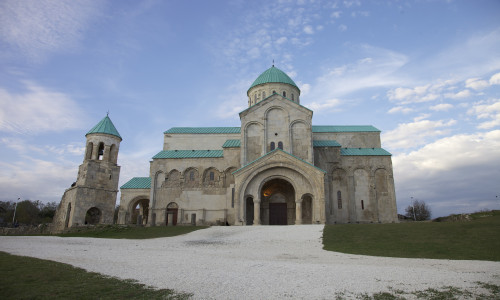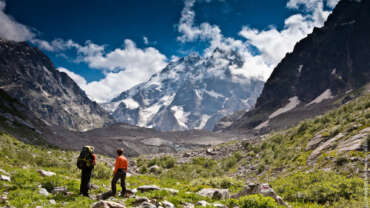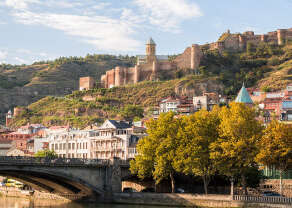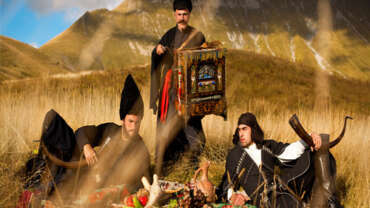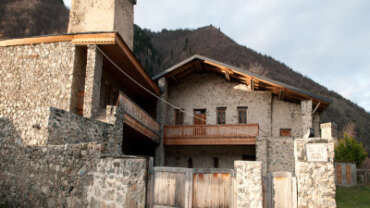Cultural Tourism in Georgia
Heritage Sites
Cave Towns Among the few notable cave towns in the world, the Georgian ones are of very special interest. Uplistsikhe, David Gareji monastery, and the world-famous cave town of Vardzia are nominated for the UNESCO World Heritage list. Uplistsikhe, ‘the fortress of the Lord’, can be dated back to the early Iron Age, and is located on a high rocky escarpment overlooking the bank of the Mtkvari River. Cut from natural sandy stone, the 8 hectares of cave-town have survived millions of people, erosion, aging and even earthquakes, but it still remains a good example of the mixture of pagan & Christian architecture.
David Gareji monastery was founded in the 6th century on the slopes of the Gareji hills by one of the thirteen Syrian Fathers, Father David (Garejeli). Those fathers were missionaries from Mesopotamia promoting and spreading Christianity, the respected founders of many monasteries and holy places around Georgia. The frescoes here are superb. Some of them date as far back as the 9th and 10th centuries. The Golden Age of Georgia is directly reflected in the incredible 11th – 13th century frescoes. The incredible cave town of Vardzia dates back to Queen Tamar’s reign, nearly a thousand years ago. Her father, King George III started the foundation of the complex, while Queen Tamar continued its construction. Many frescoes date back to the beginning of the XII century.
The complex itself consists of small chapels, bell towers, secret tunnels, monks’ caves as well as a fully functioning monastery to this day. Set in the most serene and stunning countryside, its beautiful location captures your imagination and brings you back to the era of Queen Tamar’s reign.
Bagrati Cathedral and Gelati Monastery(UNESCO WEB) The construction of Bagrati Cathedral, named after Bagrat III, the first king of united Georgia, started at the end of the 10th century and was completed in the early years of the 11th century. Although partly destroyed by the Turks in 1691, its ruins still lie in the centre of Kutaisi. The Gelati Monastery, whose main buildings were erected between the 12th and 17th centuries, is a well-preserved complex, with wonderful mosaics and wall paintings. The cathedral and monastery represent the flowering of medieval architecture in Georgia.
Historical Monuments of Mtskheta(UNESCO WEB) The historic churches of Mtskheta, former capital of Georgia, are outstanding examples of medieval religious architecture in the Caucasus. They show the high artistic and cultural level attained by this ancient kingdom.
Upper Svaneti(UNESCO WEB) Preserved by its long isolation, the Upper Svaneti region of the Caucasus is an exceptional example of mountain scenery with medieval-type villages and tower-houses. The village of Chazhashi still has more than 200 of these very unusual houses, which were used both as dwellings and as defence posts against the invaders who plagued the region.
Pilgrimage
As one of the first countries in the world to convert to Christianity, in just the 4th century AD, today Georgia is proud to provide for full religious freedom. While the majority of the country is Christian, Georgia has always been a home for people who belong to different religions… It is one of the few countries where churches, mosques, synagogues and chapels co-exist peacefully side by side. Wandering through Tbilisi one can lose count of the religious buildings and memorials, but you never feel like it is too much.
Bagrati Cathedral The construction of Bagrati Cathedral, named after Bagrat III – the first king of united Georgia, started at the end of the 10th century and was completed in the early years of the 11th century. The Cathedral holds special importance in the history of Georgia as an architectural and cultural monument.
Gelati Monastery The cathedral is situated 11 km westwards from Kutaisi. The Gelati Monastery, with its main buildings erected between the 12th and 17th centuries, was an important religious, cultural and educational center of Georgia. The monastery complex is included in UNESCO’s World Cultural Heritage list and its architecture is well known for wonderful mosaics and frescos. King David the Builder, the most celebrated King of Georgia, is buried in the yard of the monastery.
Motsameta Monastery Motsameta Monastery is located 6 kilometers from Kutaisi. The present day church dates back to the 11th century, however there are historic records stating that a church was constructed here as far back as the 8th century. Motsameta attracts crowds of tourists with an ancient superstition: if one crawls three times under the ark and makes a wish while touching the hallows, the wish will come true.
Archeology
Many countries have ancient beginnings. But very few can, like Georgia, trace their history back nearly two million years. The discovery of 1.8 million year old remains in the hills just south of Tbilisi provides the missing link in human expansion between Africa and Europe. There are many reasons to come to Georgia, and gold is just one of them. Our museums and even stories are encased with gold: gold statues and figurines, belts and crowns from ancient tribes and peoples, like the Colchis. It was the Colchis, Georgia’s ancient people, who are widely believed to have inspired some of our most famous visitors: Jason and the Argonauts.
According to legend, the Colchis owned a famous, superb Golden Fleece and Jason and the Argonauts were sent to claim it and bring it back to Greece. The fleece itself was probably inspired by the practice of sifting for gold in the high, fast flowing mountain rivers of Georgia by leaving a sheep’s fleece in the river overnight. When taken out of the river, hung from a tree and dried out, the gold can literally be brushed out. The whole story of Jason’s quest for the fleece and his meeting with the Georgian princess Medea, the famous sorceress daughter of Aeetes, King of Colchis, can still be enjoyed today in Homer’s The Odyssey.
Georgian Folklore
Georgian Music
Georgian polyphonic music tradition is world-renowned and calls upon an enchanting combination of ancient and modern harmonies. In 2001 UNESCO acknowledged this music as “a masterpiece of the world’s intangible cultural heritage”. Its unique, slightly dissonant style has not changed for centuries. The Greek historian Strabo recorded the multi-voiced chants of Georgians riding into battle as early as in the 1. century BC. The songs, made up of three-part harmonies, are still in the blood of modern society. They can be heard in churches and monasteries across the country; down Tbilisi’s back-streets of an early evening; or across the village fields in summer. They are also very much a part of the Georgian feast (supra).
Georgian Dance
Georgian dance, like the national polyphonic songs, remain a major cultural export. The Georgian State Dance Ensemble tours the world for most of the year. The vigorous, vibrant men leap high in the air; clash swords amidst flying sparks and razor sharp daggers are thrown into the floor in a frenetic, breathtaking choreography. All this is contrasting with the women’s graceful, elegant and beautiful dances. Fabulous multi-colored costumes from the many mountain regions, wild drumming, accompanied by sound of pipes and accordions… The impression is mesmeric and truly unforgettable!
Ballet
The Tbilisi Ballet has recently undergone a major refurbishment inspired by the returning of Nino Ananiashvili, former Principal Ballerina at the Bolshoi Theatre in Moscow. The performances are now of the highest quality, and they follow the tradition of dance forged by the former great Georgian dancers like George Balanchine.
The European Route Of Historic Theatres
Z. Paliashvili Opera And Ballet State Theatre
“This is the only theatre in the city, the interior of which is totally Moorish in style, and it is undoubtedly one of the most elegant, beautiful and fascinating theatre buildings that mankind has seen.” (L’Illustration, October 25, 1851) The history of the Tbilisi Opera House began 165 years ago. On April 12, 1851, the first opera house in Transcaucasia was inaugurated with a Grand Masked Ball, attended by the high society of Tbilisi. But on October 11, 1874, this opera house was destroyed by a fire. In 1896, the present building, designed by the architect Victor Schröter, was completed.
This building, too, suffered damages in the course of time, but was restored to its original form in 1978 (architects: Leri Medzmariashvili, Murtaz Chachanidze), preserving the oriental, neo-Moorish style of the building. Six rehearsal halls were included in the structure (three for ballet, two for opera and one for the orchestra), and in the foyer of the theatre, three remarkable halls – called the Red Hall, the Blue Hall and the Mirror Hall – host vocal and chamber music concerts and exhibitions.



